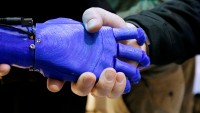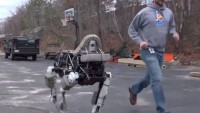Toddler Robot Proves That A Baby's Smile Is An Act Of Manipulation
| Antara Dutta Choudhury | | Sep 24, 2015 05:23 AM EDT |
Researchers from the University of California, San Diego, published a paper in PLoS ONE on Sept. 23 that indicates that babies intentionally smile to make the mother or the caregiver smile.
The paper explains that during the smile-time of the mother / caregiver and the babies, the babies smile on purpose enough to make the mother or the caregiver smile.
Like Us on Facebook
According to IEEE Spectrum, toddlers of four months and younger age cannot use gestures to influence the action of others unlike the older infants of eight months to one year of age. However, the younger toddlers smile a lot and this made the scientists question "Do the babies deliberately smile to form a means of interaction?"
The study involved three infant-mother pair volunteers, with the infants of one to four months of age. Researchers carefully observed the interaction between the mother and the infant and determined four goals the mother-infant pair tries to achieve: maximizing the time of simultaneous smiling, maximizing mother smiling, maximizing infant smiling, and nobody smiling.
On statistically analyzing facts the researchers were able to conclude that probability goal for the mother was to maximize the smile time for both the mother and the infant (about 70%), while the infants were more likely to be trying to maximize mother-only smiling (about 80%).
The researchers then employed the toddler robot, whose face was built by Hanson Robotics, with 27 moving parts. Its software aims to instruct the robot to move and communicate like a one-year-old child.
The robot was made to interact with the university students who acted as its caregiver. The robot was able to read the caregiver's expression to smile enough at the right time to get the caregiver to smile.
Movellan, a researcher in the University of Machine Perception Lab said to The San Diego Union Tribune, "It almost felt like the robot was alive."
Although researchers could throw light on the infant's goal-oriented smile, the reason why they behave that way still remains a mystery.
TagsBaby Robot, Toddler Robot, Babies Smile On Purpose, Hanson Robotics
©2015 Chinatopix All rights reserved. Do not reproduce without permission
EDITOR'S PICKS
-

Did the Trump administration just announce plans for a trade war with ‘hostile’ China and Russia?
-

US Senate passes Taiwan travel bill slammed by China
-

As Yan Sihong’s family grieves, here are other Chinese students who went missing abroad. Some have never been found
-

Beijing blasts Western critics who ‘smear China’ with the term sharp power
-

China Envoy Seeks to Defuse Tensions With U.S. as a Trade War Brews
-

Singapore's Deputy PM Provides Bitcoin Vote of Confidence Amid China's Blanket Bans
-

China warns investors over risks in overseas virtual currency trading
-

Chinese government most trustworthy: survey
-

Kashima Antlers On Course For Back-To-Back Titles
MOST POPULAR
LATEST NEWS
Zhou Yongkang: China's Former Security Chief Sentenced to Life in Prison

China's former Chief of the Ministry of Public Security, Zhou Yongkang, has been given a life sentence after he was found guilty of abusing his office, bribery and deliberately ... Full Article
TRENDING STORY

China Pork Prices Expected to Stabilize As The Supplies Recover

Elephone P9000 Smartphone is now on Sale on Amazon India

There's a Big Chance Cliffhangers Won't Still Be Resolved When Grey's Anatomy Season 13 Returns

Supreme Court Ruled on Samsung vs Apple Dispute for Patent Infringement

Microsoft Surface Pro 5 Rumors and Release Date: What is the Latest?











